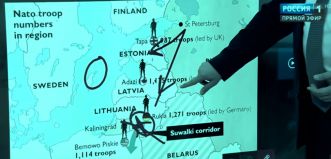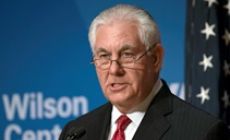Gotland has been a popular holiday destination for decades, but recently Swedish commander-in-chief, Mikael Bydén, claimed that Russian president Vladmir Putin “has his eyes” on the island. Concern was further ramped up, showing Gotland was just one part of Russia’s ambitions in the Baltics, in the last few days when Russia published a document suggesting that it needed to reassess the maritime borders in the Gulf of Finland.
That draft decree by the Russian defence ministry, which has since been removed, proposed that Russia wanted to revise its borders with Finland and Kaliningrad (based on a resolution adopted by the Soviet Union’s council of ministers in 1985) and expand its territorial waters.
Gotland holds a strategically important location of being in the middle of the Baltic Sea (halfway between Sweden and Estonia) and only 300km from where Russia’s Baltic fleet is based. Sweden joining Nato and giving it access to Gotland has significantly increased the alliance’s ability to deploy and sustain its forces in the Baltic Sea region, and this could make a decisive difference in the defence of Estonia, Latvia, Lithuania, Finland and Poland.
Because of its strategic importance, for most of the cold war Sweden maintained a large military presence on the island. But Gotland was demilitarised in 2005 in order to promote peace and cooperation in the Baltic region.
This gesture of goodwill was immediately tested by the Russians as, not long after doing so, Russian men who did not fit the usual Gotland tourist profile, began regularly visiting the island.
Then, on March 29 2013, two Tupolev Tu-22M3 nuclear bombers came within 24 miles of Gotland on dummy bombing runs. Sweden’s part-time air force had the weekend off on account of the Easter holiday, emphasising both the country’s military weakness and Gotland’s vulnerability to Russia.
After Russia invaded Crimea in 2014, Sweden took significant steps to protect itself, reintroducing 150 permanent troops on the island in 2016. By 2018, Sweden had expanded the number of permanently placed troops to 400, equipping them with CV90 armoured vehicles and Leopard 2 tanks. Air defence systems were also reactivated by 2021.
Russia’s full-scale invasion of Ukraine in 2022 led to additional reinforcements, exercises, and investment in Gotland’s defence, totalling US$160 million (£125 million). In April 2023, Sweden held its biggest military exercise in 25 years alongside Polish and British troops on the island.
For Swedish commander-in-chief Bydén, the reasons for increasing its defences in Gotland are clear. Gotland is both a major strategic asset and potential liability, and therefore must be protected in order to prevent greater threats from Russia to Nato countries from the sea.
The geographical distances in the Baltics are small, and if Russia seized Gotland in a crisis, it could dominate the Baltic Sea region. This would make it very difficult for the west to provide reinforcement to the Baltic states by sea or by air.
It’s not only Sweden that is concerned. Lithuania borders both the Russian enclave of Kaliningrad (which itself has become increasingly militarised) and Belarus, it is concerned that it could be attacked, and would then be physically isolated from the rest of the Baltics.

In usual Moscow fashion, when the online document about changing Russian maritime borders was spotted in the west, the Kremlin denied that it had any plans to do so. But there was no explanation from Russian officials as to why the ministry proposal was removed from the government’s portal.
As leaders of the Baltic countries sought clarification, Lithuania warned that this was, at the very least, another Russian intimidation tactic. Estonia’s prime minster, Kaja Kallas, went further, claiming that Russia is engaging in a “shadow war” with the west.
Shadow war in the Baltic
The Baltic Sea has already been an area of heightened tensions this year. Russian ships have stoked hostilities due to their increasingly brazen and careless behaviour, breaching maritime rules and sailing old and uninsured oil tankers, which could potentially cause an environmental catastrophe.
Russian shadow tankers (which are ships that are used in countries that have been sanctioned) have been present in Sweden’s exclusive economic zone off the eastern coast of Gotland, and have loitered off Gotland’s east coast. Russia’s fleet consists of about 1,400 ships that are not officially part of Russia’s military.
Many of these shadow tankers refuse pilotage, the practice of directing the movement of a ships by using visual or electronic observations, even when navigating Denmark’s narrow Great Belt. It appears they are engaging in forms of brinkmanship.
These provocations all take place just outside the 12 nautical mile limit (a country’s territorial waters), making it impossible for Sweden to do anything about it, as these commercial tankers are not part of Russia’s official navy. The Swedish navy has warned that Russia is likely to be using these oil tankers to engage in sabotage, reconnaissance and espionage.
Because of these developments, the Swedish prime minister informed citizens in March that they needed to be prepared for war.
In the past, Gotland was a deterrent against Soviet expansion. But Russia today under Putin seems less easily deterred and more risk-acceptant. What’s not clear is if these provocations are part of a Russian shadow war to psychologically divide and terrorise the west, or if this is a prelude to an actual war, which would certainly begin if Russia attacked Gotland.
As Sweden is now a member of Nato, this means that all members must come to Sweden’s defence should it face an attack. On its own, Sweden has a world-class and modern submarine fleet and air force and a technologically advanced defence industrial base.
Given Sweden’s military capabilities, it’s hard to predict if this is enough to deter conflict with Russia. For now, it seems, Russia is determined to create suspense around its intentions in the Baltics — a region that holds both Nato’s greatest assets and vulnerabilities. As a result, the Baltic region has become a playground in Russia’s shadow war.
![]()
Natasha Lindstaedt, Professor, Department of Government, University of Essex
This article is republished from The Conversation under a Creative Commons license. Read the original article.




